- Clone
- X54-5/7.1 (See other available formats)
- Regulatory Status
- RUO
- Other Names
- FcRI
- Isotype
- Mouse IgG1, κ
- Ave. Rating
- Submit a Review
- Product Citations
- publications

-

C57BL/6 mouse bone marrow cells were stained with CD11b (clone M1/70) FITC and CD64 (clone X54-5/7.1) Alexa Fluor® 647 (top) or mouse IgG1, κ Alexa Fluor® 647 isotype control (bottom). -

-

Mice were injected subcutaneously with sheep red blood cells in a volume of 25 µl per site on days 0 and 4 and harvested on day 11. Confocal image of C57BL/6 mouse lymph node acquired using the IBEX method of highly multiplexed antibody-based imaging: CD11c (red) in Cycle 3 and CD64 (cyan) in Cycle 6. Tissues were prepared using ~1% (vol/vol) formaldehyde and a detergent. Following fixation, samples are immersed in 30% (wt/vol) sucrose for cryoprotection. Images are courtesy of Drs. Andrea J. Radtke and Ronald N. Germain of the Center for Advanced Tissue Imaging (CAT-I) in the National Institute of Allergy and Infectious Diseases (NIAID, NIH).
| Cat # | Size | Price | Quantity Check Availability | Save | ||
|---|---|---|---|---|---|---|
| 139321 | 25 µg | £89 | ||||
| 139322 | 100 µg | £169 | ||||
CD64 is a 72 kD single chain type I glycoprotein also known as FcγRI and FcRI. CD64 is a member of the immunoglobulin superfamily and is expressed on monocytes/macrophages, dendritic cells, and mast cells. The expression can be upregulated by IFN-γ stimulation. CD64 binds IgG immune complex. It plays a role in antigen capture, phagocytosis of IgG/antigen complexes, and antibody-dependent cellular cytotoxicity (ADCC).
Product DetailsProduct Details
- Verified Reactivity
- Mouse
- Antibody Type
- Monoclonal
- Host Species
- Mouse
- Immunogen
- BALB/c mouse FcγRI-human IgG Fc fusion protein.
- Formulation
- Phosphate-buffered solution, pH 7.2, containing 0.09% sodium azide.
- Preparation
- The antibody was purified by affinity chromatography and conjugated with Alexa Fluor® 647 under optimal conditions.
- Concentration
- 0.5 mg/ml
- Storage & Handling
- The antibody solution should be stored undiluted between 2°C and 8°C, and protected from prolonged exposure to light. Do not freeze.
- Application
-
FC - Quality tested
SB - Reported in the literature, not verified in house - Recommended Usage
-
Each lot of this antibody is quality control tested by immunofluorescent staining with flow cytometric analysis. For flow cytometric staining, the suggested use of this reagent is ≤0.5 µg per million cells in 100 µl volume. It is recommended that the reagent be titrated for optimal performance for each application.
* Alexa Fluor® 647 has a maximum emission of 668 nm when it is excited at 633 nm / 635 nm.
Alexa Fluor® and Pacific Blue™ are trademarks of Life Technologies Corporation.
View full statement regarding label licenses - Excitation Laser
-
Red Laser (633 nm)
- Application Notes
-
The X54-5/7.1 antibody reacts with mouse strains carrying CD64a and b alleles but not CD64d. X54-5/7.1 recognizes a conformational determinant formed between domains 2 and 3. Additional reported application (for relevant formats) include: immunoprecipitation1, and spatial biology (IBEX)5,6. Clone X54-5/7.1 is not found to be useful for Western blots1.
- Additional Product Notes
-
Iterative Bleaching Extended multi-pleXity (IBEX) is a fluorescent imaging technique capable of highly-multiplexed spatial analysis. The method relies on cyclical bleaching of panels of fluorescent antibodies in order to image and analyze many markers over multiple cycles of staining, imaging, and, bleaching. It is a community-developed open-access method developed by the Center for Advanced Tissue Imaging (CAT-I) in the National Institute of Allergy and Infectious Diseases (NIAID, NIH).
-
Application References
(PubMed link indicates BioLegend citation) -
- Tan PS, et al. 2003. J. Immunol. 170:2549. (IP)
- Ingersoll MA, et al. 2010. Blood 115:e10. (FC)
- Ozeri E, et al. 2012. J. Immunol. 189:146. PubMed
- Richardson ML, et al. 2014. PLoS Negl Trop Dis. 8:2825. PubMed
- Radtke AJ, et al. 2020. Proc Natl Acad Sci U S A. 117:33455-65. (SB) PubMed
- Radtke AJ, et al. 2022. Nat Protoc. 17:378-401. (SB) PubMed
- Product Citations
-
- RRID
-
AB_2566560 (BioLegend Cat. No. 139321)
AB_2566561 (BioLegend Cat. No. 139322)
Antigen Details
- Structure
- Ig superfamily, type I glycoprotein, 72 kD
- Distribution
-
Monocytes, macrophages, mast cells, dendritic cells
- Function
- Phagocytosis, ADCC
- Ligand/Receptor
- IgG
- Cell Type
- Dendritic cells, Macrophages, Mast cells, Monocytes
- Biology Area
- Immunology, Innate Immunity
- Molecular Family
- CD Molecules, Fc Receptors
- Gene ID
- 14129 View all products for this Gene ID
- UniProt
- View information about CD64 on UniProt.org
Related Pages & Pathways
Pages
Related FAQs
- If an antibody clone has been previously successfully used in IBEX in one fluorescent format, will other antibody formats work as well?
-
It’s likely that other fluorophore conjugates to the same antibody clone will also be compatible with IBEX using the same sample fixation procedure. Ultimately a directly conjugated antibody’s utility in fluorescent imaging and IBEX may be specific to the sample and microscope being used in the experiment. Some antibody clone conjugates may perform better than others due to performance differences in non-specific binding, fluorophore brightness, and other biochemical properties unique to that conjugate.
- Will antibodies my lab is already using for fluorescent or chromogenic IHC work in IBEX?
-
Fundamentally, IBEX as a technique that works much in the same way as single antibody panels or single marker IF/IHC. If you’re already successfully using an antibody clone on a sample of interest, it is likely that clone will have utility in IBEX. It is expected some optimization and testing of different antibody fluorophore conjugates will be required to find a suitable format; however, legacy microscopy techniques like chromogenic IHC on fixed or frozen tissue is an excellent place to start looking for useful antibodies.
- Are other fluorophores compatible with IBEX?
-
Over 18 fluorescent formats have been screened for use in IBEX, however, it is likely that other fluorophores are able to be rapidly bleached in IBEX. If a fluorophore format is already suitable for your imaging platform it can be tested for compatibility in IBEX.
- The same antibody works in one tissue type but not another. What is happening?
-
Differences in tissue properties may impact both the ability of an antibody to bind its target specifically and impact the ability of a specific fluorophore conjugate to overcome the background fluorescent signal in a given tissue. Secondary stains, as well as testing multiple fluorescent conjugates of the same clone, may help to troubleshoot challenging targets or tissues. Using a reference control tissue may also give confidence in the specificity of your staining.
- How can I be sure the staining I’m seeing in my tissue is real?
-
In general, best practices for validating an antibody in traditional chromogenic or fluorescent IHC are applicable to IBEX. Please reference the Nature Methods review on antibody based multiplexed imaging for resources on validating antibodies for IBEX.
Other Formats
View All CD64 Reagents Request Custom Conjugation| Description | Clone | Applications |
|---|---|---|
| Purified anti-mouse CD64 (FcγRI) | X54-5/7.1 | FC,IP |
| PE anti-mouse CD64 (FcγRI) | X54-5/7.1 | FC |
| APC anti-mouse CD64 (FcγRI) | X54-5/7.1 | FC |
| PerCP/Cyanine5.5 anti-mouse CD64 (FcγRI) | X54-5/7.1 | FC |
| Brilliant Violet 421™ anti-mouse CD64 (FcγRI) | X54-5/7.1 | FC |
| Brilliant Violet 711™ anti-mouse CD64 (FcγRI) | X54-5/7.1 | FC |
| PE/Cyanine7 anti-mouse CD64 (FcγRI) | X54-5/7.1 | FC |
| FITC anti-mouse CD64 (FcγRI) | X54-5/7.1 | FC |
| Biotin anti-mouse CD64 (FcγRI) | X54-5/7.1 | FC |
| PE/Dazzle™ 594 anti-mouse CD64 (FcγRI) | X54-5/7.1 | FC |
| Alexa Fluor® 647 anti-mouse CD64 (FcγRI) | X54-5/7.1 | FC,SB |
| Brilliant Violet 605™ anti-mouse CD64 (FcγRI) | X54-5/7.1 | FC |
| TotalSeq™-A0202 anti-mouse CD64 (FcγRI) | X54-5/7.1 | PG |
| TotalSeq™-C0202 anti-mouse CD64 (FcγRI) | X54-5/7.1 | PG |
| TotalSeq™-B0202 anti-mouse CD64 (FcγRI) | X54-5/7.1 | PG |
| PE/Cyanine5 anti-mouse CD64 (FcγRI) | X54-5/7.1 | FC |
| APC/Fire™ 750 anti-mouse CD64 (FcγRI) | X54-5/7.1 | FC |
| Brilliant Violet 510™ anti-mouse CD64 (FcγRI) | X54-5/7.1 | FC |
Customers Also Purchased
Compare Data Across All Formats
This data display is provided for general comparisons between formats.
Your actual data may vary due to variations in samples, target cells, instruments and their settings, staining conditions, and other factors.
If you need assistance with selecting the best format contact our expert technical support team.
-
Purified anti-mouse CD64 (FcγRI)
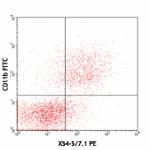
C57BL/6 bone marrow cells stained with CD11b FITC and purifi... 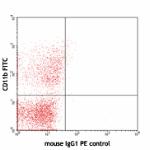
C57BL/6 bone marrow cells stained with CD11b FITC and mouse ... -
PE anti-mouse CD64 (FcγRI)

C57BL/6 bone marrow cells stained with CD11b FITC and X54-5/... 
C57BL/6 bone marrow cells stained with CD11b FITC and mouse ... -
APC anti-mouse CD64 (FcγRI)
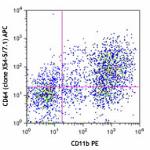
C57BL/6 mouse bone marrow cells were stained with CD11b PE a... 
-
PerCP/Cyanine5.5 anti-mouse CD64 (FcγRI)

C57BL/6 mouse bone marrow cells were stained with CD11b APC ... -
Brilliant Violet 421™ anti-mouse CD64 (FcγRI)
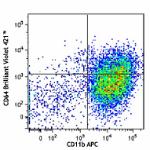
C57BL/6 mouse bone marrow cells were stained with CD11b APC ... 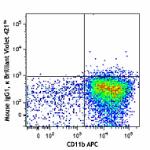
-
Brilliant Violet 711™ anti-mouse CD64 (FcγRI)
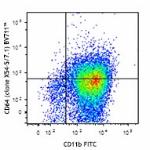
C57BL/6 mouse bone marrow cells were stained with CD11b FITC... 
-
PE/Cyanine7 anti-mouse CD64 (FcγRI)

C57BL/6 mouse bone marrow cells were stained with CD11b APC ... -
FITC anti-mouse CD64 (FcγRI)
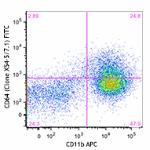
C57BL/6 mouse bone marrow cells were stained with CD11b (clo... 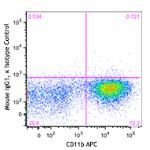
-
Biotin anti-mouse CD64 (FcγRI)
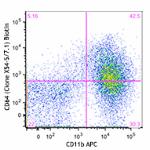
C57BL/6 mouse bone marrow cells were stained with CD11b (clo... 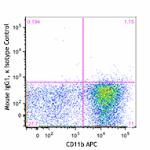
-
PE/Dazzle™ 594 anti-mouse CD64 (FcγRI)
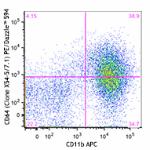
C57BL/6 mouse bone marrow cells were stained with CD11b (clo... 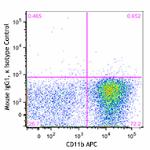
-
Alexa Fluor® 647 anti-mouse CD64 (FcγRI)
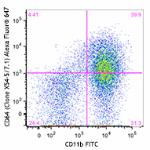
C57BL/6 mouse bone marrow cells were stained with CD11b (clo... 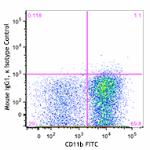
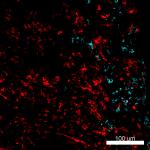
Mice were injected subcutaneously with sheep red blood cells... -
Brilliant Violet 605™ anti-mouse CD64 (FcγRI)
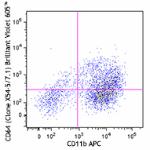
C57BL/6 mouse bone marrow cells were stained with CD11b APC ... 
-
TotalSeq™-A0202 anti-mouse CD64 (FcγRI)
-
TotalSeq™-C0202 anti-mouse CD64 (FcγRI)
-
TotalSeq™-B0202 anti-mouse CD64 (FcγRI)
-
PE/Cyanine5 anti-mouse CD64 (FcγRI)

C57BL/6 mouse bone marrow cells were stained with anti-mouse... -
APC/Fire™ 750 anti-mouse CD64 (FcγRI)

C57BL/6 mouse bone marrow cells were stained with anti-mouse... -
Brilliant Violet 510™ anti-mouse CD64 (FcγRI)

C57BL/6 mouse bone marrow was stained with anti-mouse/human ...
 Login / Register
Login / Register 











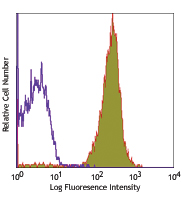
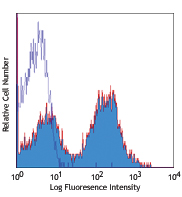
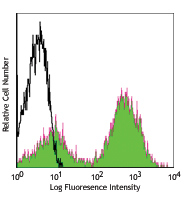



Follow Us